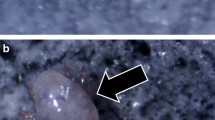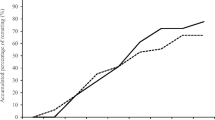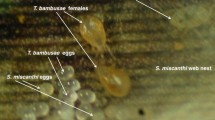Abstract
We studied the effect of mating frequency on female longevity and fecundity in the mite Caloglyphus berlesei. We tested the hypothesis that high promiscuity is selected for in this species because females receive nutrients during copulation. Females were constantly exposed to either one or four males and fed either a standard or poor diet. The prediction that frequent mating benefits females was not confirmed. On the contrary, females kept with four males had significantly lower longevity on both diets and on the standard diet they also had decreased fecundity compared to females exposed to one male. On the poor diet the number of males had no significant effect on fecundity. Thus, increased mating frequency had a detrimental effect on female fitness.
Similar content being viewed by others
REFERENCES
Arnqvist, G. 1989. Multiple mating in water strider: mutual benefits or intersexual conflict. Animal Behav. 48: 1049–1056.
Bateman, A.J. 1948. Intra-sexual selection in Drosophila. Heredity 2: 349–368.
Boczek, J. and Griffiths, D.A. 1979. Spermatophore production and mating behaviour in the stored products mites Acarus siro and Lardoglyphus konoi. In Recent advances in acarology, J.G. Rodriguez (ed.), pp. 279–284. Academic Press, New York.
Boggs, C.L. and Gilbert, L.E. 1979. Male contribution to egg production in butterflies: evidence for transfer of nutrients at mating. Science 206: 83–84.
Burpee, D.M. and Sakaluk, S. 1993. Repeated matings offset costs of reproduction in female crickets. Evol. Evol. 7: 240–250.
Chapman, T. and Partridge, L. 1996. Female fitness in Drosophila melanogaster: an interaction between the effect of nutrition and of encounter rate with males. Proc. R. Soc. Lond. B. 263: 755–759.
Chapman, T., Liddie, L.F., Kalb, J.M., Wolfner, M.F. and Partridge, L. 1995. Cost of mating in Drosophila melanogaster females is mediated by male assessory gland products. Nature 373: 241–244.
Eberhard, W.G. 1996. Females in Control: Sexual Selection by Cryptic Female Choice. Princeton University Press, Princeton.
Erkay, S.A. 1987. Observations on the biology of two species of acarid mites. Folia Entomol. Hung. 48: 21–27.
Gerson, U., Capua, S. and Thorens, D. 1983. Life history and life tables of Rhizoglyphus robini Cleparede (Acari: Astigmata: Acaridae). Acarologia 24: 439–448.
Griffiths, D.A. and Boczek, J. 1977. Spermatophores of some acaroid mites (Astigmata: Acarina). Int. J. Insect Morphol. Embryol. 6: 231–238.
Gwynne, D.T. 1988. Courtship feeding and the fitness of female katydids (Orthoptera: Tettigoniidae). Evolution 42: 545–555.
Halliday, T.A. and Arnold, S.J. 1987. Multiple mating by females: a perspective from quantitative genetics. Animal Behav. 35: 939–941.
Harshman, L.G. and Prout, T. 1994. Sperm displacement without sperm transfer in Drosophila melanogaster. Evolution 48: 758–766.
Kaitala, A. and Wiklund, C. 1994. Polyandrous female butterflies forage for matings. Behav. Ecol. Sociobiol. 35: 385–388.
Keller, L. 1995. All's fair when love is war. Nature 373: 190–191.
Keller, L. and Reeve, H.K. 1995. Why do females mate with multiple males? The sexually selected sperm hypothesis. Adv. Stud. Behav. 24: 291–315.
LaMunyon, C.W. 1997. Increased fecundity, as a function of multiple mating, in an arctiid moth, Utetheisa ornatrix. Ecol. Entomol. 22: 69–73.
Linley, J.R. and Simmons, K.R. 1981. Sperm motility and spermathecal filling in lower diptera. Int. J. Invertebr. Reproduct. 4: 137–146.
Madsen, T., Shine, R., Loman, J. and Hakansson, T. 1992. Why do female adders copulate so frequently? Nature 355: 440–441.
Mehta, C. and Patel, N. 1992. StatXact-Turbo, Statistical Software for Exact Nonparametric Interference. CYTEL Software Corporation, Cambridge, MA.
O'Connor, B.M. 1979. Evolutionary origins of astigmatid mites inhabiting stored products. In J.G. Rodriguez (ed), Recent advances in acarology, 1, pp. 273–278. Academic Press, New York.
Parker, G.A. 1970. Sperm competition and its evolutionary consequences in the insects. Biol. Rev. 45: 525–561.
Pillai, P.R.P. and Winston, P.W. 1969. Life history and biology of Caloglyphus anomalus Nesbitt (Acarina: Acaridae). Acarologia 11: 295–303.
Radwan, J. 1991. Sperm competition in the mite Caloglyphus berlesei. Behav. Ecol. Sociobiol. 29: 291–296.
Radwan, J. 1992. The influence of a crowded environment on the size of males of Caloglyphus berlesei. Int. J. Acarol. 18: 67–68.
Radwan, J. 1995. Male morph determination in two species of acarid mites. Heredity 74: 669–673.
Radwan, J. 1996. Intraspecific variation in sperm competition success: a role for sperm size. Proc. R. Soc. Lond. B. 263: 855–859.
Radwan, J. 1998. Heritability of sperm competition success in the bulb mite, Rhizoglyphus robini. J. Evol. Biol. 11: 321–327.
Radwan, J. and Siva-Jothy, M.T. 1996. The function of postinsemination mate association in the bulb mite Rhizoglyphus robini. Animal Behav. 52: 651–657.
Radwan, J. and Witaliński, W. 1991. Sperm competition. Nature 352: 671–672.
Ridley, M. 1988. Mating frequency and fecundity in insects. Biol. Rev. 63: 509–549.
Schwartz, J.M. and Boake, C.R.B. 1992. Sexual dimorphism in remating in Hawaiian Drosophila species. Animal Behav. 44: 231–238.
Simmons, L.W. 1990. Nuptial feeding in insects: male costs and the rates of fecundity increase. Behav. Ecol. Sociobiol. 27: 43–47.
Stockley, P., Searle, J.B., Macdonald, D.W. and Jones, C.S. 1993. Female multiple mating behaviour in the common shrew as a strategy to reduce inbreeding. Proc. R. Soc. Lond. B 254: 173–179.
Svärd, L. and Wiklund, C. 1988. Fecundity, egg weight and longevity in relation to multiple mating in females of the monarch butterfly. Behav. Ecol. Sociobiol. 23: 39–43.
Szendlak, E., Boczek, J., Bruce, W. and Davis, R. 1985. Effect of gamma-radiated males on egg production in Acarus siro. Fla. Entomol. 68: 286–290.
Timms, S., Ferro, D.N. and Emberson, R.M. 1981. General biology and nomenclature of Sancassania berlesei. Acarologia 22: 385–390.
Wilkinson, L., Hill, M., Howe, P. and Miceli, S. 1992. SYSTAT for Windows, Version 5 Edition. SYSTAT, Inc., Evanston, IL.
Witaliński, W., Szendlak, E. and Boczek, J. 1990. Anatomy and ultrastructure of the reproductive systems of Acarus siro (Acari: Acaridae). Exp. Appl. Acarol. 10: 1–31.
Yasui, Y. 1997. A ‘good-sperm’ model can explain the evolution of costly multiple mating by females. Am. Nat. 149: 573–583.
Zeh, J.A. 1997. Polyandry and enhanced reproductive success in the harlequin-beetle-riding pseudoscorpion. Behav. Ecol. Sociobiol. 40: 111–118.
Zeh, J.A. and Zeh, D.W. 1996. The evolution of polyandry I: intragenomic conflict and genetic incompatibility. Proc. R. Soc. Lond. B 263: 1711–1717.
Zeh, J.A. and Zeh, D.W. 1997. The evolution of polyandry II: post-copulatory defences against genetic incompatibility. Proc. R. Soc. Lond. B 264: 69–75.
Author information
Authors and Affiliations
Corresponding author
Rights and permissions
About this article
Cite this article
Radwan, J., Rysińska, M. Effect of Mating Frequency on Female Fitness in Caloglyphus Berlesei (Astigmata: Acaridae). Exp Appl Acarol 23, 399–409 (1999). https://doi.org/10.1023/A:1006125909154
Issue Date:
DOI: https://doi.org/10.1023/A:1006125909154




